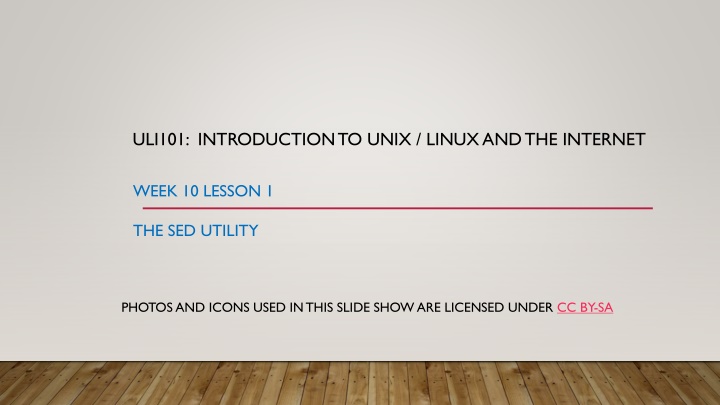
Introduction to Sed Utility in Unix and Linux
Learn about the sed utility in Unix and Linux, its purpose, usage, addressing methods, common instructions, and an example command. Sed is a powerful streaming editor used to manipulate text efficiently without altering the original file.
Download Presentation

Please find below an Image/Link to download the presentation.
The content on the website is provided AS IS for your information and personal use only. It may not be sold, licensed, or shared on other websites without obtaining consent from the author. If you encounter any issues during the download, it is possible that the publisher has removed the file from their server.
You are allowed to download the files provided on this website for personal or commercial use, subject to the condition that they are used lawfully. All files are the property of their respective owners.
The content on the website is provided AS IS for your information and personal use only. It may not be sold, licensed, or shared on other websites without obtaining consent from the author.
E N D
Presentation Transcript
ULI101: INTRODUCTION TO UNIX / LINUX AND THE INTERNET WEEK 10 LESSON 1 THE SED UTILITY PHOTOS AND ICONS USED IN THIS SLIDE SHOW ARE LICENSED UNDER CC BY-SA
LESSON 1 TOPICS The sed Utility Definition / Purpose Usage Using sed as a Filter with Pipeline Commands Demonstration Perform Week 10 Tutorial Investigation 1 Review Questions (Parts A and B)
SED UTILITY Purpose The sed command stands for Streaming Editor. The sed command is used to manipulate text that is contained in a text file or via a pipeline command. Although the sed command does NOT change content inside a text file, this command acts like a on-the-fly text editor to display modified text on the screen, redirect to a file or act as a filter within a pipeline command.
SED UTILITY Usage: sed [-n] 'address instruction' filename How it Works: The sed command reads all lines in the input file and will be exposed to the expression (i.e. area contained within quotes) one line at a time. The expression can be within single quotes or double quotes. The expression contains an address (match condition) and an instruction (operation). If the line matches the address, then it will perform the instruction. Lines will display be default unless the n option is used to suppress default display
SED UTILITY Usage: sed [-n] 'address instruction' filename Addresses: Can use a line number, to select a specific line (for example: 5) Can specify a range of line numbers (for example: 5,7) Regular expressions are contained within forward slashes (e.g. /regular-expression/) Can specify a regular expression to select all lines that match a pattern (e.g /^[0-9].*[0-9]$/) If NO address is present, the instruction will apply to ALL lines
SED UTILITY Usage: sed [-n] 'address instruction' filename Common Instructions: p Print lines that match the address (commonly used with -n option) d Omit (delete) display of lines that match the address q Print lines including line that matches address and then quit processing s Substitute text to replace a matched regular expression (similar search and replace)
SED UTILITY Example 1 The following sed command line displays all lines in the readme file that contain the word line (all lowercase). In addition, because there is no n option, sed displays all the lines of input. As a result, sed displays the lines that contain the word line twice. sed '/line/ p' readme Line one. The second line. The second line. The third. This is line four. This is line four. Five. This is the sixth sentence. This is line 7. This is line 7. Eight and last. Unless you instruct it not to, sed sends all lines, selected or not to standard output. When you use the n option on the command line, sed sends only those lines to stdout that you specify with the print p command
SED UTILITY Example 2 The following sed command displays contents of a file from a range of line numbers. sed -n '3,6 p' readme The third. This is line four. Five. This is the sixth sentence. The print p instruction using the n option only displays lines 3 through 6.
SED UTILITY Example 3 The following sed command displays the first five lines of text just as a head -5 lines command would. sed '5 q' readme Line one. The second line. The third. This is line four. Five. The sed command prints all lines, beginning from the first line, In this example, sed will terminate when line 5 is matched.
SED UTILITY Example 4 The following sed command displays a TAB character for lines contained in a file. The regular expression in the following instruction (^.) matches one character at the beginning of every line that is not empty. $ sed 's/^./\t&/' readme Line one. The second line. The third. etc... The replacement string (between the second and third forward slashes) contains a backslash escape sequence that represents a TAB character (\t) followed by an ampersand (&). The ampersand character (&) takes on the value of what the regular expression matched.
SED UTILITY Example 5 The following sed command uses a regular expression and the quit instruction. sed '/[0-9][0-9][0-9]$/ q' myfile sfun 11 cool 12 Super 12a Happy112 The regular expression in the following expression [0-9][0-9][0-9]$ matches three digits at the end of a line. The command will process the file, one-line at a time, beginning at the top and (by default) outputting each line to standard output. Once the regular expression is matched, it will display the matched line and stop processing the sed command.
SED UTILITY Using sed Utility as a Filter with Pipeline Commands Although sed can be used as a streaming editor for text contained within a text file, the sed command can also be used as a filter within a pipeline command. Examples ls | sed 's/^[0-9]/x/g echo I like Linux | sed 's/ /,/g'
SED UTILITY Instructor Demonstration Your professor will demonstrate additional examples using the sed utility. Contents of cars database file: Pathname of cars database: ~murray.saul/uli101/cars plym fury 77 73 2500 chevy nova 79 60 3000 ford mustang 65 45 17000 volvo gl 78 102 9850 ford ltd 83 15 10500 Chevy nova 80 50 3500 fiat 600 65 115 450 honda accord 81 30 6000 ford thundbd 84 10 17000 toyota tercel 82 180 750 chevy impala 65 85 1550 ford bronco 83 25 9525 Commands sed -n '3,6 p' cars sed '5 d' cars sed '5,8 d' cars sed '5 q' cars sed -n '/chevy/ p' cars sed '/chevy/ d' cars sed '/chevy/ q' cars sed 's/[0-9]/*/' cars sed 's/[0-9]/*/g' cars sed '5,8 s/[0-9]/*/' cars sed 's/[0-9][0-9]*/*** & ***/' cars
HOMEWORK Getting Practice Perform Week 10 Tutorial: (Due: Friday Week 11 @ midnight for a 2% grade): INVESTIGATION 1: USING THE SED UTILITY LINUX PRACTICE QUESTIONS (Parts A and B)
